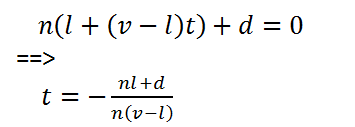最简单的阴影技术---Planar Shadow
前言
这篇博客中,我将介绍一种最简单的阴影技术(Planar Shadow)和Cg Effect框架cgfx的简单使用。最近我在写一个简单的渲染引擎,设计考虑跨渲染API(opengl and direct3d),暂时不跨平台(linux and window), 限定在Windows平台上。引擎计划加入Effect框架,就想D3D Effect那样,在OpenGL层,我暂时考虑使用cgfx,D3D的则直接使用fx框架。所以没有办法,在shader上面,暂时没有办法做到一套统一的shader。学习图形学的时间也不长,所以我是边写简单的Demo边写引擎框架,以后读研的时候,再深入研究一下。
Planar Shadow Matrix
Planar Shadow的思想很简单,根据光源和投影面位置推导一个投影矩阵,通过这个矩阵能把模型上所有顶点投射到投影面(比如地面)上,也就是将渲染物体压扁到一个平面上。投影矩阵的推到也挺容易的。
L是光源的位置,V是模型上顶点的位置,P是把模型上顶点投影到接受阴影面上的点。
投影平面(即接受阴影的平面)方程:![]()
推导如下
(1)直线LV上的点P的坐标是![]() ,其中t是个参数。
,其中t是个参数。
(2)其中P在接受阴影的平面上,把(1)带入平面方程,得到
(3)把t 代入(1),得到
根据上面推导得到的关系,按照xyz展开,就可以得到P 跟 V之间的关系,可以用一个矩阵表示,使得M v = P
计算Shadow Matrix的函数
void MakePlanarShadowMatrix( float planeNormalX, float planeNormalY, float planeNormalZ, float planeDist, float lightX, float lightY, float lightZ, Matrix4f& shadowMatrix )
{
float nDotl = planeNormalX * lightX + planeNormalY * lightY + planeNormalZ * lightZ ;
shadowMatrix.m[0][0] = nDotl + planeDist - planeNormalX * lightX;
shadowMatrix.m[0][1] = -lightX * planeNormalY;
shadowMatrix.m[0][2] = -lightX * planeNormalZ;
shadowMatrix.m[0][3] = -lightX * planeDist;
shadowMatrix.m[1][0] = -lightY * planeNormalX;
shadowMatrix.m[1][1] = nDotl + planeDist - lightY * planeNormalY;
shadowMatrix.m[1][2] = -lightY * planeNormalZ;
shadowMatrix.m[1][3] = -lightY * planeDist;
shadowMatrix.m[2][0] = -lightZ * planeNormalX;
shadowMatrix.m[2][1] = -lightZ * planeNormalY;
shadowMatrix.m[2][2] = nDotl + planeDist - lightZ * planeNormalZ;
shadowMatrix.m[2][3] = -lightZ * planeDist;
shadowMatrix.m[3][0] = -planeNormalX;
shadowMatrix.m[3][1] = -planeNormalY;
shadowMatrix.m[3][2] = -planeNormalZ;
shadowMatrix.m[3][3] = nDotl;
}
cg shader effect Cgfx
想必用过Direct3D 10 的人都会觉得Effect的框架,对于写简单Demo很好用。Cgfx是对应于cg Shader 语言的Effect框架。在学习OpenGL的过程中,我是模仿D3D10, 完全使用可编程管线,不再使用OpenGL固定管线。所以,需要自己计算View,Projection Matrix,每次渲染需要自己写Shader。
最简单cgfx的使用大致如下,具体见代码:
- Create CgContext
- Create Effect
- Get Technique From Effect
- Get Parameter From Effect
- Set Parameter
- For each pass in technique, Draw
Planar Shadow Demo 不需要复杂的Shader,绘制阴影只是简单的是世界变化矩阵里乘上一个Shadow Matrix, 把模型压扁到接受阴影的平面上。所以我使用了Per-Pixel Texture Lighting Shader,就当看完书实践一下。
下面是我使用的Effect File, 最简单的Per-Pixel Lighting,没有加入高光.
float4x4 WorldMatrix : World;
float4x4 ViewMatrix : View;
float4x4 ProjectionMatrix : Projection;
float3 LightPositon;
float3 LightColor;
float3 AmbientLight = float3(0.2, 0.2, 0.2);
int Shadow; // if 1, draw planar shadow
sampler2D DiffuseMap = sampler_state {
MinFilter = Linear;
MagFilter = Linear;
WrapS = Wrap;
WrapT = Wrap;
};
struct VertexShaderInput
{
float4 Pos : POSITION;
float3 Normal : NORMAL;
float2 Tex : TEXCOORD0;
};
struct VertexShaderOutput
{
float4 Pos : POSITION;
float2 Tex : TEXCOORD0;
float3 Normal : TEXCOORD1;
float3 WorldPos : TEXCOORD2;
};
VertexShaderOutput VertexShaderFunction(VertexShaderInput input)
{
VertexShaderOutput output;
output.Pos = mul( WorldMatrix, input.Pos );
output.Pos = mul( ViewMatrix, output.Pos );
output.Pos = mul( ProjectionMatrix, output.Pos );
output.Tex = input.Tex;
output.WorldPos = mul(WorldMatrix, input.Pos);
output.Normal = mul((float3x3)WorldMatrix, input.Normal);
return output;
}
float4 PixelShaderFunction(VertexShaderOutput input) : COLOR
{
float4 renderColor = float4(0, 0, 0, 1);
if(!Shadow)
{
float3 lightVec = normalize(input.WorldPos - LightPositon);
float diffuseFactor = saturate( dot(-lightVec, input.Normal) );
float3 diffuseMaterial = tex2D(DiffuseMap, input.Tex);
float3 diffuseColor = diffuseFactor * LightColor * diffuseMaterial;
float3 ambientColor = AmbientLight * diffuseMaterial;
renderColor = float4(diffuseColor + ambientColor, 1);
}
return renderColor;
}
technique TextureLightingTech
{
pass
{
CullFaceEnable = true;
CullFace = Back;
//PolygonMode = int2(Front, Line);
VertexProgram = compile gp4vp VertexShaderFunction();
FragmentProgram = compile gp4fp PixelShaderFunction();
}
}
主要注意事项和需要改进之处
1、 因为压扁后的阴影正好跟接受阴影平面的位置重合,所以在绘制接受面后,再绘制阴影的时候,就可能出现Z-Fighting现象。所以使用了PolygonOffset的方法使得Shadow的位置产生一点偏移,出现在接受平面的上方。具体设置如下,参考网上的方法
glEnable( GL_POLYGON_OFFSET_FILL );
glPolygonOffset( -0.1f, 0.2f );
glPolygonOffset( 0.0f, 0.0f );
glDisable( GL_POLYGON_OFFSET_FILL );
2、 暂时没有使用Stencil Buffer控制阴影的绘制的位置,所以不管阴影落在接受面里面还是外面,都要绘制。
3、 我发现一种情况,当遮挡物(即产生阴影的物体)有一部分位于平面下方的时候,这部分是不应该产生阴影的,但用投影的方法,在平面下方的部分还是会投影到 平面上产生阴影,按照数学公式,确实是应该这样的,但对于阴影来说,却是不正确的。
以后所有的代码我都放在github上, https://github.com/hust-ruan/GraphicsLearning



